
Oomycete
Ring Rot Or Disease
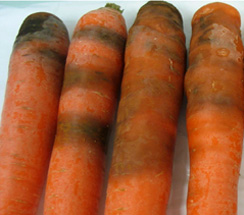


Ring rot or disease caused by Phytophthora megasperma in carrot is characterized by a progressive decomposition of the roots and neck of the plants. Symptoms generally begin in the roots, spreading towards the stem and causing general weakening of the plant.
- Discoloration and watery Taches on the roots
- Appearance of a ring of rot around the neck of the plant
- Necrosis of root and stem tissues
- Wilting and yellowing of foliage
- Plant collapse in advanced stages of infection
Insect
Carrot Weevil
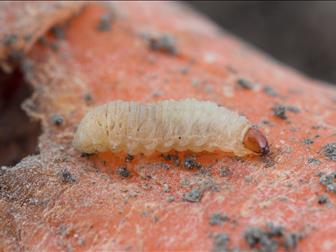
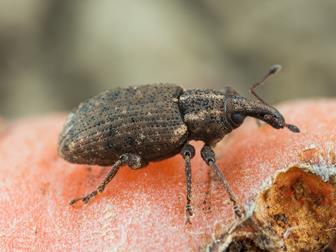

The carrot weevil causes a disease in carrots that can significantly affect their quality and yield. The main damage is caused by larvae feeding on the roots, which can lead to deformation, stunted growth and, in severe cases, death of the plant. Affected carrots show visible symptoms on both the aerial part and the roots.
- Holes and tunnels in the roots.
- Deformations and scars on carrots.
- Wilting and chlorosis of the leaves.
- Delay in plant growth.
- Loss of vigor.
- Death of young seedlings.
Bacterium
Carrot Scab



Carrot scab, caused by Streptomyces scabies, is a disease that primarily affects the appearance and quality of carrot roots. Infected roots develop superficial lesions that can become rough and warty, decreasing the commercial value of the crop.
- Rough lesions and scabs on the surface of the carrots.
- Brown discoloration in affected areas.
- Deformations and cracks in the roots.
- Warty and rough appearance.
- Reduction in plant growth and vigor.
- Loss of commercial quality of carrots.
Insect
Thrips


%20PGRO.JPG)
Frankliniella occidentalis infestation on carrots causes the disease known as thrips, which can result in significant damage to both the quality and quantity of the crop. Thrips feed by sucking cellular juices from the leaves and roots, which can weaken the plant and affect its development.
- Silvery or discolored Taches on the leaves.
- Dotted and wrinkled feeding areas.
- Distortion and malformation of the leaves.
- Reduction in the vigor and growth of plants.
- Healing on the surface of the roots.
- Delay in the development of carrots.
Fungus
Brown Crown And Root Rot
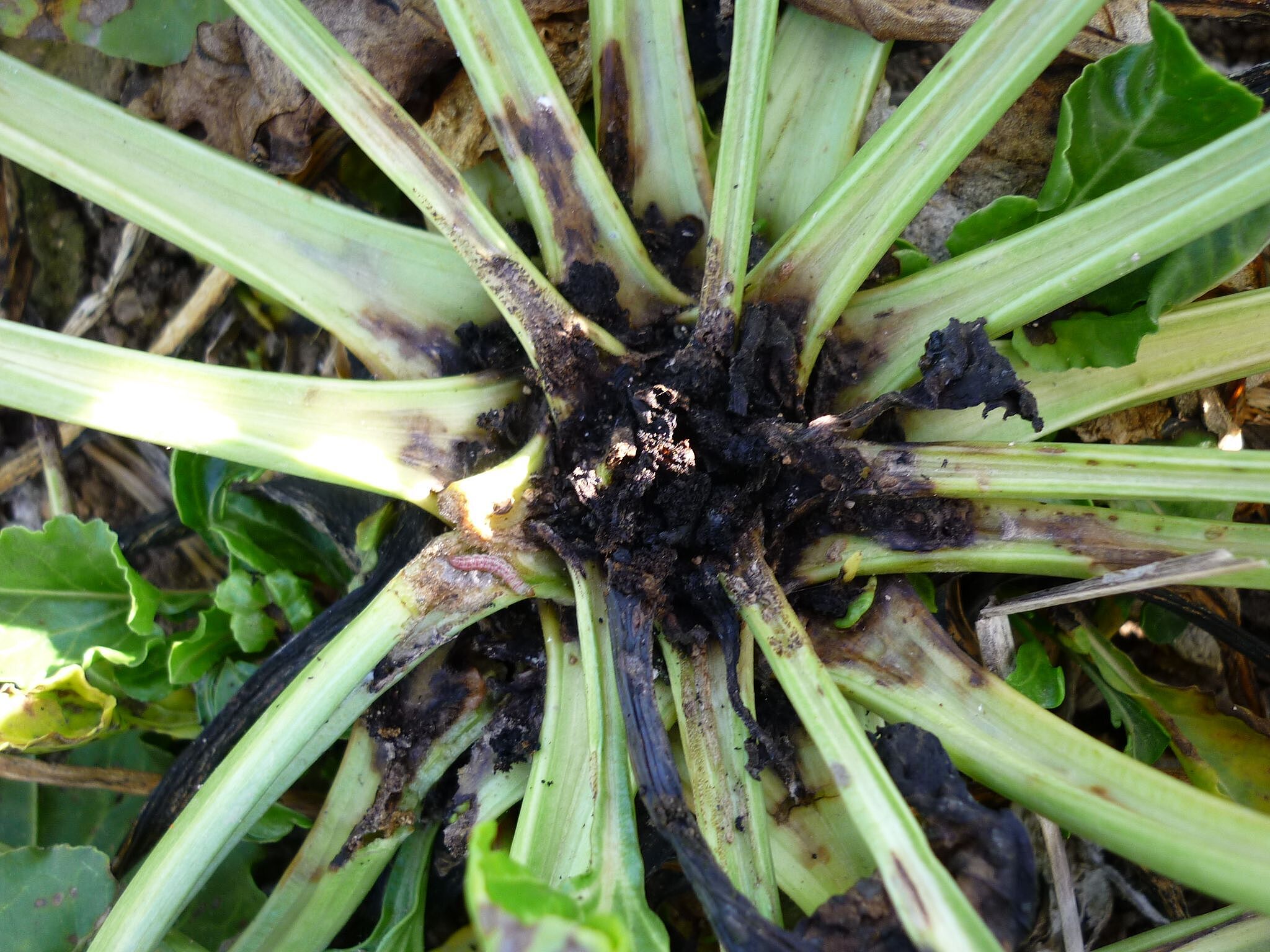
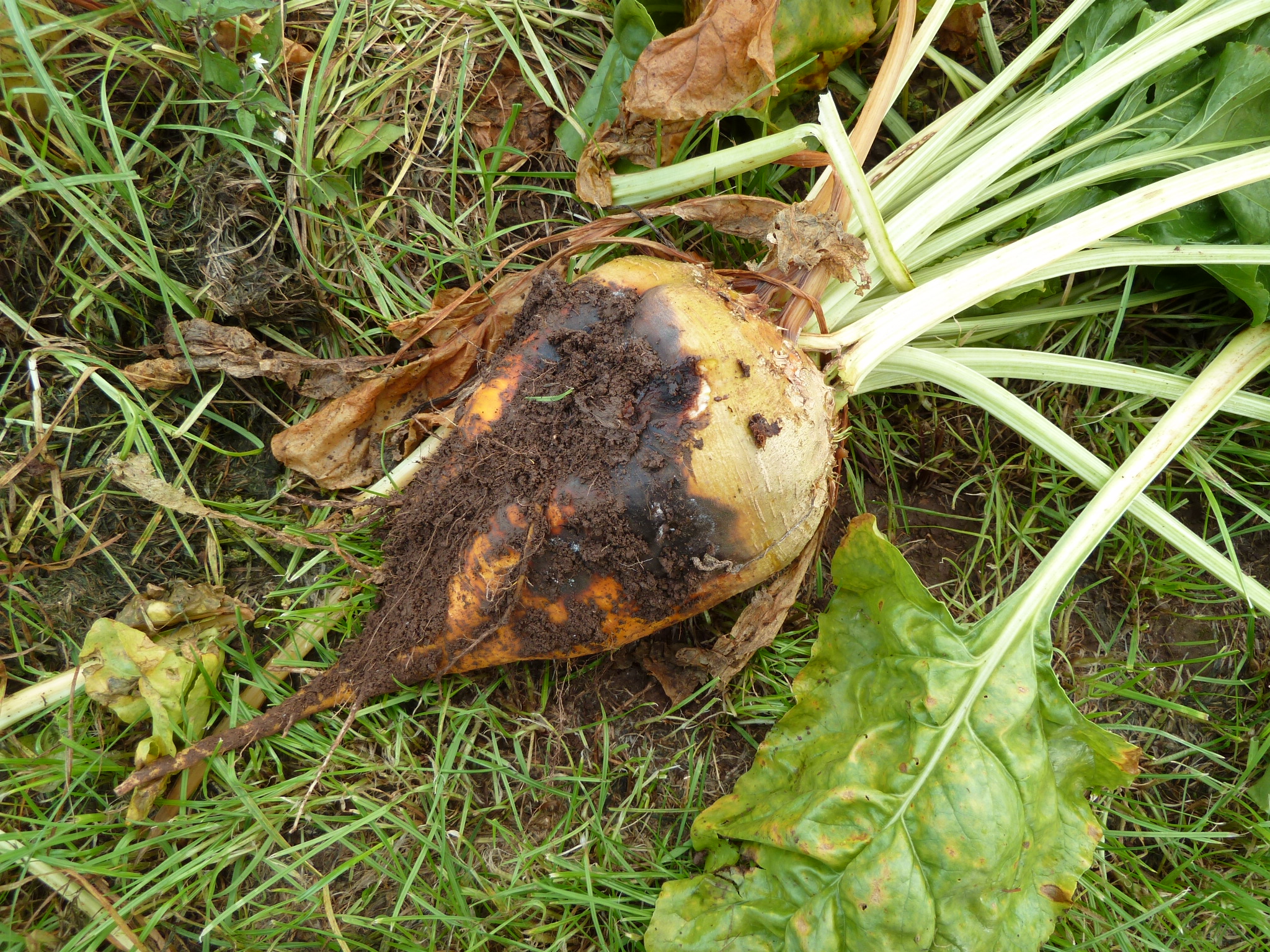
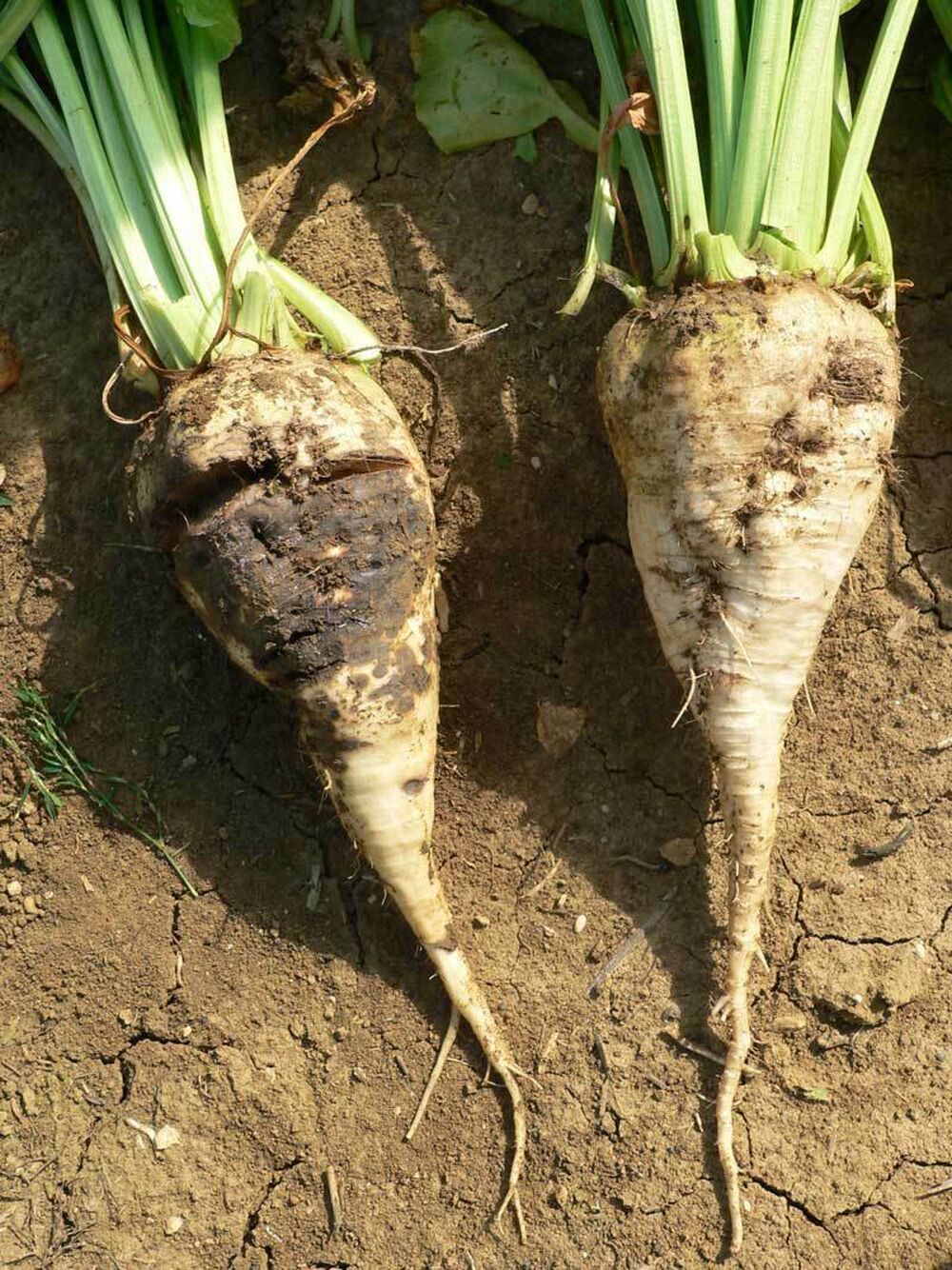
Brown crown and root rot, caused by Rhizoctonia solani, is a devastating disease of beet. This fungus infects the underground parts of the plant, causing a series of symptoms that affect both the development and yield of the crop. The disease initially manifests itself as brown Taches at the base of the plant, which progressively expand. The roots and crown are affected, showing dark brown decay and tissue collapse. Affected plants usually show stunted growth and may die if the infection is severe. The roots become soft and give off an unpleasant odor as the rot progresses.
- Brown Taches at the base of the plant
- Dark brown decay on roots and crown
- Stunted growth
- Death of severely infected plants
- Soft roots with an unpleasant odor
Fungus
Bad Vinous



Wine disease, caused by Rhizoctonia violacea, severely affects beets, compromising both their development and productivity. The disease initially manifests itself as purple Taches on the roots and crown of the plant, which expand and darken over time. These Taches are the result of the breakdown of plant tissue, which turns brown and then black as the disease progresses. Affected plants show poor growth, wilting and, in severe cases, may die.
- Purple Taches on the roots and crown
- Decomposition of plant tissue
- Darkening of Taches to brown and black
- Poor plant growth
- Wilting
- Death of severely affected plants
Fungus
Phomosis
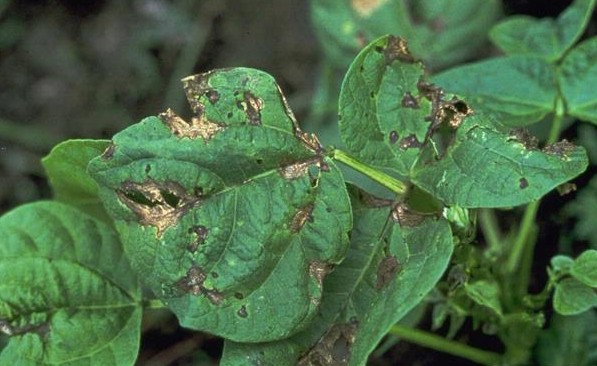
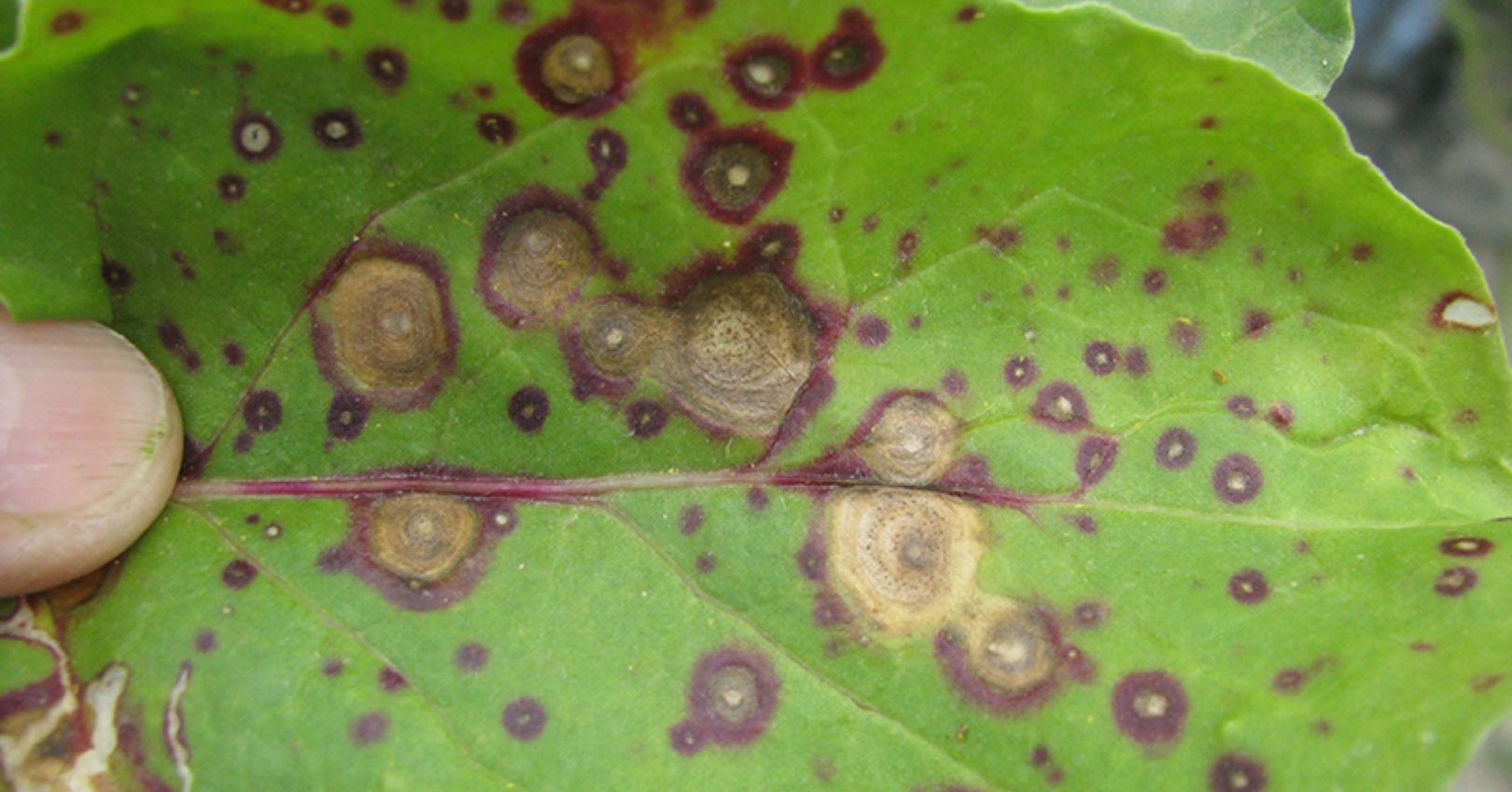

Phomosis, caused by Phoma betae, is a disease that severely affects beets, compromising their quality and yield. The first symptoms are seen as small dark Taches on the leaves and crown of the plant. These Taches expand and become necrotic, causing sunken, discolored lesions. The infection extends to the roots, where black or brown Taches can be seen, which deepen and cause internal rot. Infected plants show delayed growth and wilting, especially in high humidity conditions.
- Small dark Taches on the leaves and crown
- Sunken and discolored lesions
- Black or brown Taches on the roots
- Internal root rot
- Delayed growth
- Wilting in high humidity conditions
Fungus
Sclerotium Disease, Southern Blight Or Southern Blight


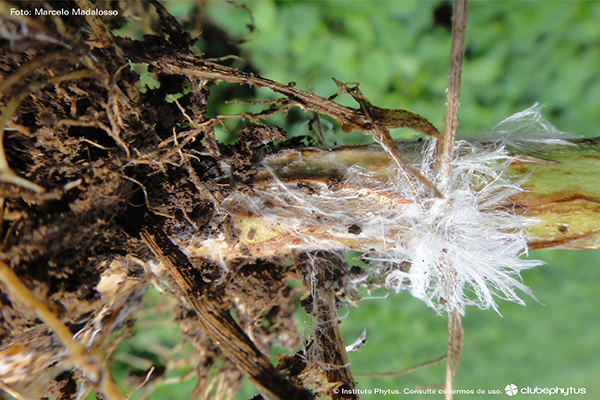
Sclerotium disease, southern blight or southern blight caused by Sclerotium rolfsii in beets manifests itself with a series of distinctive symptoms. Initially, infected plants show wilting and chlorosis of the lower leaves, which then progresses to the upper leaves. The roots and the base of the stem may show brown lesions and soft rot, accompanied by a layer of white mycelium and the presence of sclerotia in the infected tissue.
- Withering and chlorosis of the lower leaves.
- Brown lesions on the roots and base of the stem.
- Soft rot at the base of the stem.
- Presence of white cottony mycelium in the soil and infected tissues.
- Formation of brown sclerotia in the affected tissues.
- General decay of the plant.
Fungus
Ramularia
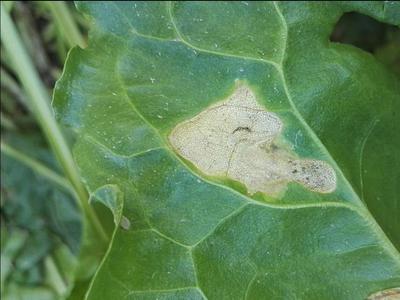


Ramularia caused by Ramularia betícola significantly affects beets, manifesting first in the lower leaves and progressing to the upper ones. Early signs include small chlorotic Taches that develop into dark brown necrotic lesions, surrounded by a yellow halo. These lesions can coalesce, causing significant defoliation and reducing photosynthesis and crop yield. Under severe conditions, plants may experience widespread wilting and premature death.
- Small chlorotic Taches on the leaves.
- Dark brown necrotic lesions with a yellow halo.
- Coalescence of lesions causing defoliation.
- Reduction of photosynthesis.
- Generalized wilting.
- Premature death of the plant.
Fungus
Alternariosis



Alternariosis caused by Alternaria tenuis in beet is characterized by the appearance of dark Taches on the leaves, which gradually enlarge and become necrotic. These Taches can coalesce, resulting in premature defoliation that affects photosynthesis and, therefore, plant growth and yield. Severely affected plants may show symptoms of wilting and poor overall development, compromising the quality and quantity of the harvest.
- Dark Taches on the leaves.
- Necrotic lesions that enlarge.
- Coalescence of stains.
- Premature defoliation.
- Reduction of photosynthesis.
- Wilting and poor development of the plant.
Fungus
Powdery Mildew



Powdery mildew in table beets is a disease that mainly affects the leaves, reducing photosynthesis and weakening the plant. Symptoms include white powdery Taches covering the surface of leaves and other aerial organs. Infected leaves may turn yellow and drop prematurely, which decreases the plant's ability to produce and store sugars, affecting crop yield and quality.
- White powdery Taches on leaves and stems.
- Yellowing and premature leaf fall.
- Reduction of photosynthesis.
- General weakening of the plant.
- Decrease in crop yield and quality.
Fungus
Rust



Beet rust caused by Uromyces betae is a disease that mainly affects the leaves, decreasing photosynthetic efficiency and weakening the plant. Severe infections can significantly reduce crop yield and quality.
- Appearance of orange to reddish pustules on the surface of the leaves.
- Yellowing and death of affected leaves.
- Reduction of photosynthesis and general weakening of the plant.
- Development of lesions that can merge, covering large areas of the leaves.
- Premature fall of infected leaves.
Insect
Cassida



In table beets, infestation by Cassida vittata produces a disease known as cassid. Damage is caused by both adults and larvae, who feed on leaf tissue, creating necrotic areas that interfere with photosynthesis and normal plant growth.
- Presence of irregular holes in the leaves.
- Transparent areas on the leaves due to the removal of the parenchyma.
- Withered and discolored leaves.
- Reduction in the effective leaf surface for photosynthesis.
- Weakened plants and lower root yield.
- Visible presence of adults and larvae on the underside of the leaves.
Virus
Rhizomania
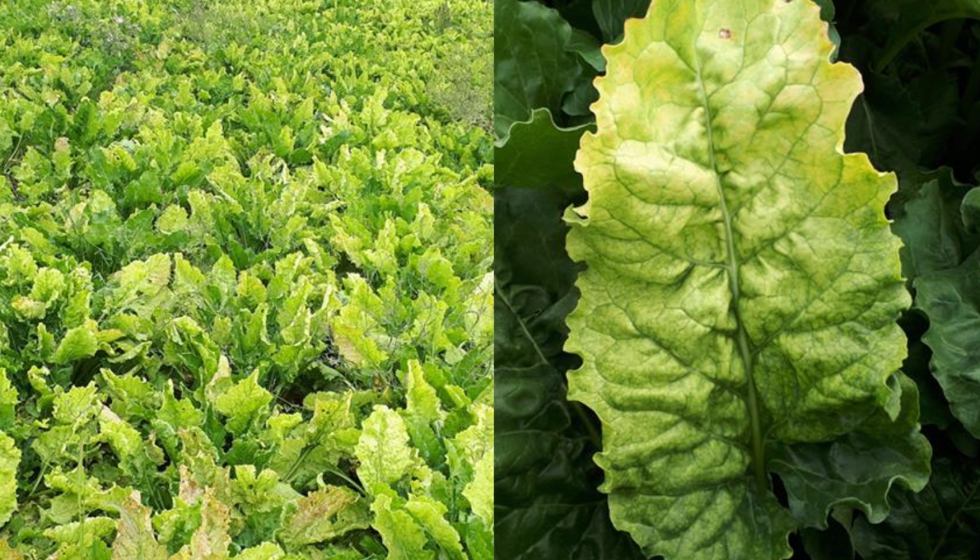

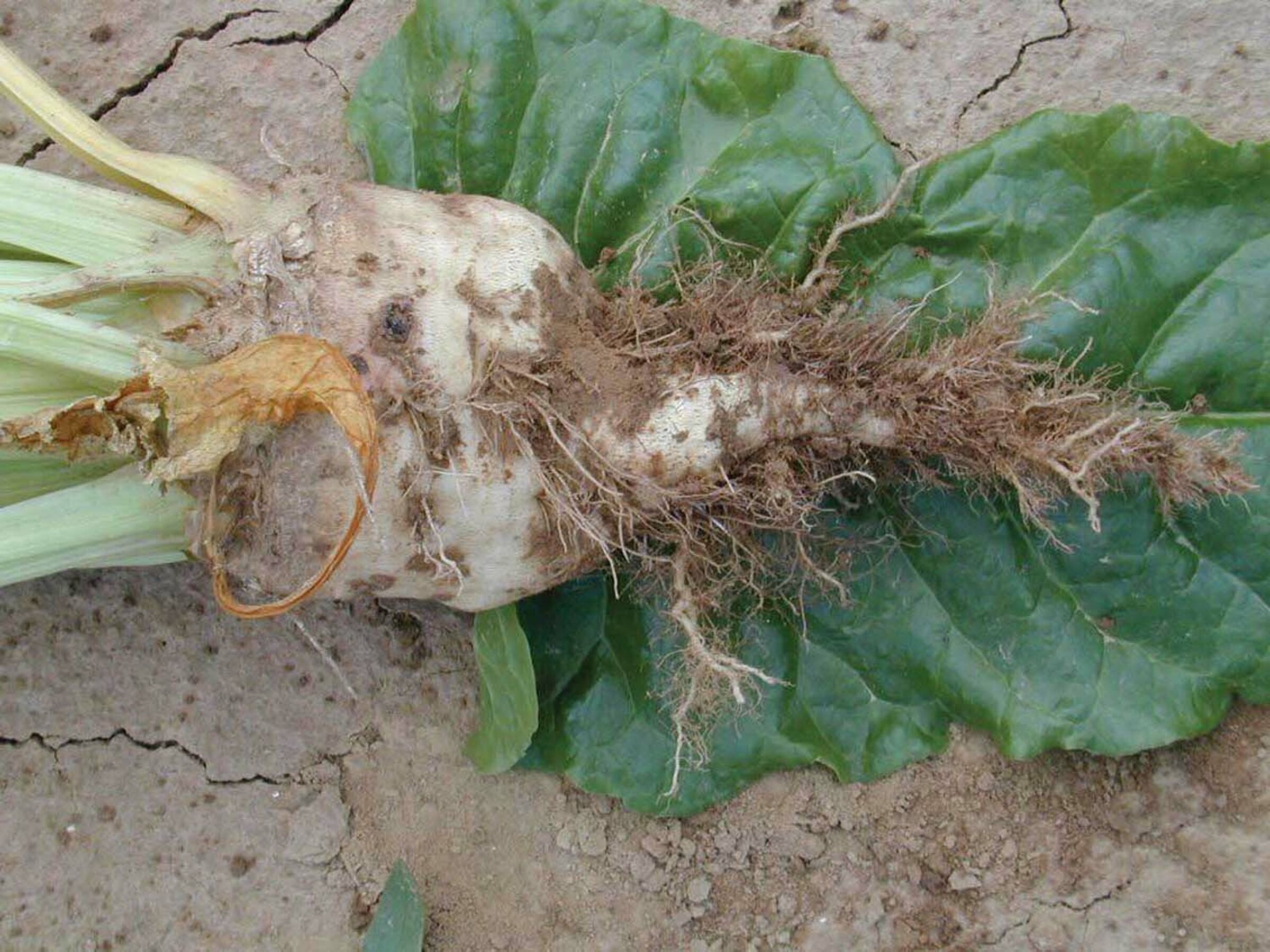
Rhizomania is a devastating disease that affects beets, causing a significant decrease in root production and quality. Initial symptoms include yellowing and necrosis of leaf veins, followed by general wilting of the plant. As the infection progresses, the roots show abnormal and excessive growth of secondary roots, known as "beards." This results in deformed and smaller roots, negatively affecting crop yield. Additionally, infected plants may show delayed growth and reduced tolerance to other stress factors.
- Yellowing of the veins of the leaves
- Vein necrosis
- General wilting of the plant
- Abnormal growth of secondary roots
- Deformed and smaller roots
- Delayed growth
Virus
Beet Yellowness Virus



The beet yellow virus affects beet plants, causing a series of symptoms that significantly decrease the quality and yield of the crop. The disease initially manifests itself with yellowing of the leaves, which progressively spreads throughout the plant. As the infection progresses, the leaves may show reddening and upward curling, accompanied by a reduction in plant growth. This results in less root development, affecting both their size and quality.
- Yellowing of the leaves
- Redness of the leaves
- Upward curling of the leaves
- Reduction in plant growth
- Decrease in root size
- Loss of root quality
Oomycete
Ring Rot Or Disease



Ring rot or disease caused by Phytophthora megasperma in carrot is characterized by a progressive decomposition of the roots and neck of the plants. Symptoms generally begin in the roots, spreading towards the stem and causing general weakening of the plant.
- Discoloration and watery Taches on the roots
- Appearance of a ring of rot around the neck of the plant
- Necrosis of root and stem tissues
- Wilting and yellowing of foliage
- Plant collapse in advanced stages of infection
Insect
Carrot Weevil



The carrot weevil causes a disease in carrots that can significantly affect their quality and yield. The main damage is caused by larvae feeding on the roots, which can lead to deformation, stunted growth and, in severe cases, death of the plant. Affected carrots show visible symptoms on both the aerial part and the roots.
- Holes and tunnels in the roots.
- Deformations and scars on carrots.
- Wilting and chlorosis of the leaves.
- Delay in plant growth.
- Loss of vigor.
- Death of young seedlings.
Bacterium
Carrot Scab



Carrot scab, caused by Streptomyces scabies, is a disease that primarily affects the appearance and quality of carrot roots. Infected roots develop superficial lesions that can become rough and warty, decreasing the commercial value of the crop.
- Rough lesions and scabs on the surface of the carrots.
- Brown discoloration in affected areas.
- Deformations and cracks in the roots.
- Warty and rough appearance.
- Reduction in plant growth and vigor.
- Loss of commercial quality of carrots.
Insect
Thrips


%20PGRO.JPG)
Frankliniella occidentalis infestation on carrots causes the disease known as thrips, which can result in significant damage to both the quality and quantity of the crop. Thrips feed by sucking cellular juices from the leaves and roots, which can weaken the plant and affect its development.
- Silvery or discolored Taches on the leaves.
- Dotted and wrinkled feeding areas.
- Distortion and malformation of the leaves.
- Reduction in the vigor and growth of plants.
- Healing on the surface of the roots.
- Delay in the development of carrots.
Fungus
Brown Crown And Root Rot



Brown crown and root rot, caused by Rhizoctonia solani, is a devastating disease of beet. This fungus infects the underground parts of the plant, causing a series of symptoms that affect both the development and yield of the crop. The disease initially manifests itself as brown Taches at the base of the plant, which progressively expand. The roots and crown are affected, showing dark brown decay and tissue collapse. Affected plants usually show stunted growth and may die if the infection is severe. The roots become soft and give off an unpleasant odor as the rot progresses.
- Brown Taches at the base of the plant
- Dark brown decay on roots and crown
- Stunted growth
- Death of severely infected plants
- Soft roots with an unpleasant odor
Fungus
Bad Vinous



Wine disease, caused by Rhizoctonia violacea, severely affects beets, compromising both their development and productivity. The disease initially manifests itself as purple Taches on the roots and crown of the plant, which expand and darken over time. These Taches are the result of the breakdown of plant tissue, which turns brown and then black as the disease progresses. Affected plants show poor growth, wilting and, in severe cases, may die.
- Purple Taches on the roots and crown
- Decomposition of plant tissue
- Darkening of Taches to brown and black
- Poor plant growth
- Wilting
- Death of severely affected plants
Fungus
Phomosis



Phomosis, caused by Phoma betae, is a disease that severely affects beets, compromising their quality and yield. The first symptoms are seen as small dark Taches on the leaves and crown of the plant. These Taches expand and become necrotic, causing sunken, discolored lesions. The infection extends to the roots, where black or brown Taches can be seen, which deepen and cause internal rot. Infected plants show delayed growth and wilting, especially in high humidity conditions.
- Small dark Taches on the leaves and crown
- Sunken and discolored lesions
- Black or brown Taches on the roots
- Internal root rot
- Delayed growth
- Wilting in high humidity conditions
Fungus
Sclerotium Disease, Southern Blight Or Southern Blight



Sclerotium disease, southern blight or southern blight caused by Sclerotium rolfsii in beets manifests itself with a series of distinctive symptoms. Initially, infected plants show wilting and chlorosis of the lower leaves, which then progresses to the upper leaves. The roots and the base of the stem may show brown lesions and soft rot, accompanied by a layer of white mycelium and the presence of sclerotia in the infected tissue.
- Withering and chlorosis of the lower leaves.
- Brown lesions on the roots and base of the stem.
- Soft rot at the base of the stem.
- Presence of white cottony mycelium in the soil and infected tissues.
- Formation of brown sclerotia in the affected tissues.
- General decay of the plant.
Fungus
Ramularia



Ramularia caused by Ramularia betícola significantly affects beets, manifesting first in the lower leaves and progressing to the upper ones. Early signs include small chlorotic Taches that develop into dark brown necrotic lesions, surrounded by a yellow halo. These lesions can coalesce, causing significant defoliation and reducing photosynthesis and crop yield. Under severe conditions, plants may experience widespread wilting and premature death.
- Small chlorotic Taches on the leaves.
- Dark brown necrotic lesions with a yellow halo.
- Coalescence of lesions causing defoliation.
- Reduction of photosynthesis.
- Generalized wilting.
- Premature death of the plant.
Fungus
Alternariosis



Alternariosis caused by Alternaria tenuis in beet is characterized by the appearance of dark Taches on the leaves, which gradually enlarge and become necrotic. These Taches can coalesce, resulting in premature defoliation that affects photosynthesis and, therefore, plant growth and yield. Severely affected plants may show symptoms of wilting and poor overall development, compromising the quality and quantity of the harvest.
- Dark Taches on the leaves.
- Necrotic lesions that enlarge.
- Coalescence of stains.
- Premature defoliation.
- Reduction of photosynthesis.
- Wilting and poor development of the plant.
Fungus
Powdery Mildew



Powdery mildew in table beets is a disease that mainly affects the leaves, reducing photosynthesis and weakening the plant. Symptoms include white powdery Taches covering the surface of leaves and other aerial organs. Infected leaves may turn yellow and drop prematurely, which decreases the plant's ability to produce and store sugars, affecting crop yield and quality.
- White powdery Taches on leaves and stems.
- Yellowing and premature leaf fall.
- Reduction of photosynthesis.
- General weakening of the plant.
- Decrease in crop yield and quality.
Fungus
Rust



Beet rust caused by Uromyces betae is a disease that mainly affects the leaves, decreasing photosynthetic efficiency and weakening the plant. Severe infections can significantly reduce crop yield and quality.
- Appearance of orange to reddish pustules on the surface of the leaves.
- Yellowing and death of affected leaves.
- Reduction of photosynthesis and general weakening of the plant.
- Development of lesions that can merge, covering large areas of the leaves.
- Premature fall of infected leaves.
Insect
Cassida



In table beets, infestation by Cassida vittata produces a disease known as cassid. Damage is caused by both adults and larvae, who feed on leaf tissue, creating necrotic areas that interfere with photosynthesis and normal plant growth.
- Presence of irregular holes in the leaves.
- Transparent areas on the leaves due to the removal of the parenchyma.
- Withered and discolored leaves.
- Reduction in the effective leaf surface for photosynthesis.
- Weakened plants and lower root yield.
- Visible presence of adults and larvae on the underside of the leaves.
Virus
Rhizomania



Rhizomania is a devastating disease that affects beets, causing a significant decrease in root production and quality. Initial symptoms include yellowing and necrosis of leaf veins, followed by general wilting of the plant. As the infection progresses, the roots show abnormal and excessive growth of secondary roots, known as "beards." This results in deformed and smaller roots, negatively affecting crop yield. Additionally, infected plants may show delayed growth and reduced tolerance to other stress factors.
- Yellowing of the veins of the leaves
- Vein necrosis
- General wilting of the plant
- Abnormal growth of secondary roots
- Deformed and smaller roots
- Delayed growth
Virus
Beet Yellowness Virus



The beet yellow virus affects beet plants, causing a series of symptoms that significantly decrease the quality and yield of the crop. The disease initially manifests itself with yellowing of the leaves, which progressively spreads throughout the plant. As the infection progresses, the leaves may show reddening and upward curling, accompanied by a reduction in plant growth. This results in less root development, affecting both their size and quality.
- Yellowing of the leaves
- Redness of the leaves
- Upward curling of the leaves
- Reduction in plant growth
- Decrease in root size
- Loss of root quality
Oomycete
Ring Rot Or Disease



Ring rot or disease caused by Phytophthora megasperma in carrot is characterized by a progressive decomposition of the roots and neck of the plants. Symptoms generally begin in the roots, spreading towards the stem and causing general weakening of the plant.
- Discoloration and watery Taches on the roots
- Appearance of a ring of rot around the neck of the plant
- Necrosis of root and stem tissues
- Wilting and yellowing of foliage
- Plant collapse in advanced stages of infection
Insect
Carrot Weevil



The carrot weevil causes a disease in carrots that can significantly affect their quality and yield. The main damage is caused by larvae feeding on the roots, which can lead to deformation, stunted growth and, in severe cases, death of the plant. Affected carrots show visible symptoms on both the aerial part and the roots.
- Holes and tunnels in the roots.
- Deformations and scars on carrots.
- Wilting and chlorosis of the leaves.
- Delay in plant growth.
- Loss of vigor.
- Death of young seedlings.
Bacterium
Carrot Scab



Carrot scab, caused by Streptomyces scabies, is a disease that primarily affects the appearance and quality of carrot roots. Infected roots develop superficial lesions that can become rough and warty, decreasing the commercial value of the crop.
- Rough lesions and scabs on the surface of the carrots.
- Brown discoloration in affected areas.
- Deformations and cracks in the roots.
- Warty and rough appearance.
- Reduction in plant growth and vigor.
- Loss of commercial quality of carrots.
Insect
Thrips


%20PGRO.JPG)
Frankliniella occidentalis infestation on carrots causes the disease known as thrips, which can result in significant damage to both the quality and quantity of the crop. Thrips feed by sucking cellular juices from the leaves and roots, which can weaken the plant and affect its development.
- Silvery or discolored Taches on the leaves.
- Dotted and wrinkled feeding areas.
- Distortion and malformation of the leaves.
- Reduction in the vigor and growth of plants.
- Healing on the surface of the roots.
- Delay in the development of carrots.
Fungus
Brown Crown And Root Rot



Brown crown and root rot, caused by Rhizoctonia solani, is a devastating disease of beet. This fungus infects the underground parts of the plant, causing a series of symptoms that affect both the development and yield of the crop. The disease initially manifests itself as brown Taches at the base of the plant, which progressively expand. The roots and crown are affected, showing dark brown decay and tissue collapse. Affected plants usually show stunted growth and may die if the infection is severe. The roots become soft and give off an unpleasant odor as the rot progresses.
- Brown Taches at the base of the plant
- Dark brown decay on roots and crown
- Stunted growth
- Death of severely infected plants
- Soft roots with an unpleasant odor
Fungus
Bad Vinous



Wine disease, caused by Rhizoctonia violacea, severely affects beets, compromising both their development and productivity. The disease initially manifests itself as purple Taches on the roots and crown of the plant, which expand and darken over time. These Taches are the result of the breakdown of plant tissue, which turns brown and then black as the disease progresses. Affected plants show poor growth, wilting and, in severe cases, may die.
- Purple Taches on the roots and crown
- Decomposition of plant tissue
- Darkening of Taches to brown and black
- Poor plant growth
- Wilting
- Death of severely affected plants
Fungus
Phomosis



Phomosis, caused by Phoma betae, is a disease that severely affects beets, compromising their quality and yield. The first symptoms are seen as small dark Taches on the leaves and crown of the plant. These Taches expand and become necrotic, causing sunken, discolored lesions. The infection extends to the roots, where black or brown Taches can be seen, which deepen and cause internal rot. Infected plants show delayed growth and wilting, especially in high humidity conditions.
- Small dark Taches on the leaves and crown
- Sunken and discolored lesions
- Black or brown Taches on the roots
- Internal root rot
- Delayed growth
- Wilting in high humidity conditions
Fungus
Sclerotium Disease, Southern Blight Or Southern Blight



Sclerotium disease, southern blight or southern blight caused by Sclerotium rolfsii in beets manifests itself with a series of distinctive symptoms. Initially, infected plants show wilting and chlorosis of the lower leaves, which then progresses to the upper leaves. The roots and the base of the stem may show brown lesions and soft rot, accompanied by a layer of white mycelium and the presence of sclerotia in the infected tissue.
- Withering and chlorosis of the lower leaves.
- Brown lesions on the roots and base of the stem.
- Soft rot at the base of the stem.
- Presence of white cottony mycelium in the soil and infected tissues.
- Formation of brown sclerotia in the affected tissues.
- General decay of the plant.
Fungus
Ramularia



Ramularia caused by Ramularia betícola significantly affects beets, manifesting first in the lower leaves and progressing to the upper ones. Early signs include small chlorotic Taches that develop into dark brown necrotic lesions, surrounded by a yellow halo. These lesions can coalesce, causing significant defoliation and reducing photosynthesis and crop yield. Under severe conditions, plants may experience widespread wilting and premature death.
- Small chlorotic Taches on the leaves.
- Dark brown necrotic lesions with a yellow halo.
- Coalescence of lesions causing defoliation.
- Reduction of photosynthesis.
- Generalized wilting.
- Premature death of the plant.
Fungus
Alternariosis



Alternariosis caused by Alternaria tenuis in beet is characterized by the appearance of dark Taches on the leaves, which gradually enlarge and become necrotic. These Taches can coalesce, resulting in premature defoliation that affects photosynthesis and, therefore, plant growth and yield. Severely affected plants may show symptoms of wilting and poor overall development, compromising the quality and quantity of the harvest.
- Dark Taches on the leaves.
- Necrotic lesions that enlarge.
- Coalescence of stains.
- Premature defoliation.
- Reduction of photosynthesis.
- Wilting and poor development of the plant.
Fungus
Powdery Mildew



Powdery mildew in table beets is a disease that mainly affects the leaves, reducing photosynthesis and weakening the plant. Symptoms include white powdery Taches covering the surface of leaves and other aerial organs. Infected leaves may turn yellow and drop prematurely, which decreases the plant's ability to produce and store sugars, affecting crop yield and quality.
- White powdery Taches on leaves and stems.
- Yellowing and premature leaf fall.
- Reduction of photosynthesis.
- General weakening of the plant.
- Decrease in crop yield and quality.
Fungus
Rust



Beet rust caused by Uromyces betae is a disease that mainly affects the leaves, decreasing photosynthetic efficiency and weakening the plant. Severe infections can significantly reduce crop yield and quality.
- Appearance of orange to reddish pustules on the surface of the leaves.
- Yellowing and death of affected leaves.
- Reduction of photosynthesis and general weakening of the plant.
- Development of lesions that can merge, covering large areas of the leaves.
- Premature fall of infected leaves.
Insect
Cassida



In table beets, infestation by Cassida vittata produces a disease known as cassid. Damage is caused by both adults and larvae, who feed on leaf tissue, creating necrotic areas that interfere with photosynthesis and normal plant growth.
- Presence of irregular holes in the leaves.
- Transparent areas on the leaves due to the removal of the parenchyma.
- Withered and discolored leaves.
- Reduction in the effective leaf surface for photosynthesis.
- Weakened plants and lower root yield.
- Visible presence of adults and larvae on the underside of the leaves.
Virus
Rhizomania



Rhizomania is a devastating disease that affects beets, causing a significant decrease in root production and quality. Initial symptoms include yellowing and necrosis of leaf veins, followed by general wilting of the plant. As the infection progresses, the roots show abnormal and excessive growth of secondary roots, known as "beards." This results in deformed and smaller roots, negatively affecting crop yield. Additionally, infected plants may show delayed growth and reduced tolerance to other stress factors.
- Yellowing of the veins of the leaves
- Vein necrosis
- General wilting of the plant
- Abnormal growth of secondary roots
- Deformed and smaller roots
- Delayed growth
Virus
Beet Yellowness Virus



The beet yellow virus affects beet plants, causing a series of symptoms that significantly decrease the quality and yield of the crop. The disease initially manifests itself with yellowing of the leaves, which progressively spreads throughout the plant. As the infection progresses, the leaves may show reddening and upward curling, accompanied by a reduction in plant growth. This results in less root development, affecting both their size and quality.
- Yellowing of the leaves
- Redness of the leaves
- Upward curling of the leaves
- Reduction in plant growth
- Decrease in root size
- Loss of root quality























